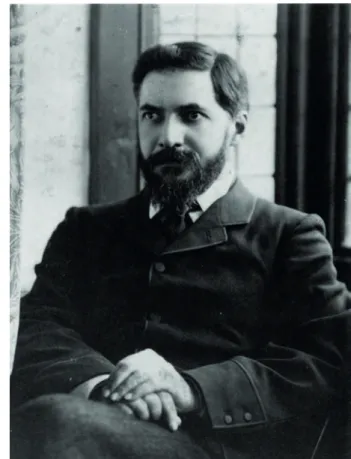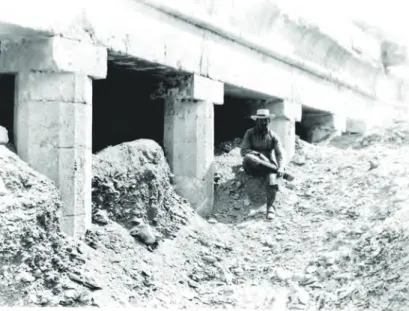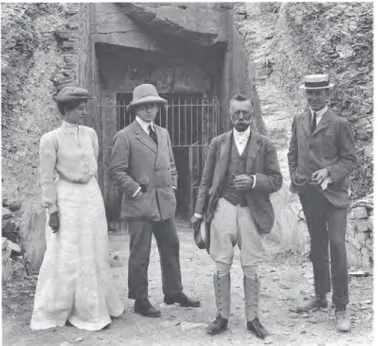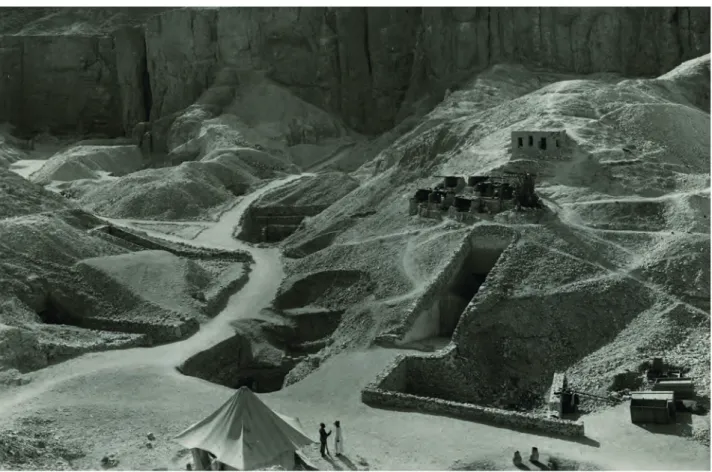Collection Aegyptiaca Leodiensia 12
TUTANKHAMUN
DISCOVERING THE FORGOTTEN PHARAOH
Catalogue edited by
Simon Connor and Dimitri Laboury
Exhibition organized at the Europa Expo space
TGV train station “Les Guillemins”
Liège, 14th December 2019 – 30th August 2020
Presses Universitaires de Liège
2020
The exhibition “Tutankhamun. Discovering the
Forgotten Pharaoh” was produced by the scrl-fs Europa Expo and realised by the non-profit organisation Collections & Patrimoines.
Commissioner: René Schyns
Curators: Dimitri Laboury and Simon Connor Managing Director: Alain Mager
Operational and financial management: Marie Kupper Technical Director: Agostinho da Cunha
Human Resources Department and ticketing: Rosabella
Sanchez
Scientific Committee: Jean-Michel Bruffaerts, Simon
Connor, Alisée Devillers, Pierre Hallot, Dimitri Laboury, Hugues Tavier, Claudia Venier
Conception: Dimitri Laboury, Simon Connor, Alix
Nyssen, Guy Lemaire, René Schyns
Artistic direction: Christian Merland, Sophie Meurisse,
Geneviève Schyns
Direction of the reconstitution of pharaonic sets: Hugues
Tavier
Communication: CARACASCOM.com, Manfred
Dahmen, Lionel Halleux
Attaché of direction: Youri Martin Computer graphics: Michael Van Raek
Texts, legends and audio guides: Eddy Przybylski Shelf Coordinator: Laurent Dillien
Workshop manager: Julien Sevenants
Set designers: Ahmed Hassan, Maurice Lai, Joëlle
Luremonde, David Hermans, Maïti Simon, Daniel Voisin, Philippe Weerts
Lights: Carlo Casuccio, Renaud Lavigne
Carpenters: Stefano Azzalin and Benjamin Bouillot Fitters: Mike Tambour, Pascal Norga, Nicolas Detrooz,
Alain Parmentier.
Ironwork: Pierre Leboulange Sound engineer: Serge Winandy Technicians: e.m.c. Filippo Pultrone
Translation of texts in the exhibition: Vanessa Davies,
Maud Slingenberg; colingua
Audio guides: rsf/trillenium
EUROPA EXPO scrl-fs
President: Karl-Heinz Lambertz
Administrators: Anne Faway-Reul, Marie Kupper,
Laurence Schyns and René Schyns
Managing Director: Alain Mager
COLLECTIONS & PATRIMOINES asbl
President: René Schyns
Administrators: Claude Dedye, Charlotte Ferrara, Michel
Konen, Guy Lemaire, Christian Merland and Jean-Claude Phlypo
Managing Director: Alain Mager
LENDING INSTITUTIONS
Germany
– Hildesheim, Roemer- und Pelizaeus-Museum – Karlsruhe, Badisches Landesmuseum – Baden State
Museum
– Tübingen, Ägyptische Sammlung der Eberhard Karls Universität Tübingen
England
– Cambridge, Fitzwilliam Museum
– Manchester, Manchester Museum – University of Manchester
– Private collectors
Belgium
– Brussels, Royal Museums of Art and History – Brussels, royal palace
– Morlanwez, Musée Royal de Mariemont – Private collectors
Canada
– Toronto, Bata Shoe Museum
Spain
– Private collector
France
– Paris, Musée du Louvre
– Strasbourg, Institut d’Égyptologie de l’Université de Strasbourg
– Private collector
Netherlands
– Leiden, Rijksmuseum van Oudheden Acknowledgements
Jean-Lou Stefan
The anonymous private collectors who entrusted us with their pieces.
This book is dedicated to the memory of Agostinho da Cunha, untimely seized by the Abductor, as ancient Egyptians called it.
The Exhibition ...15
Tutankhamun. Discovering the Forgotten Pharaoh [Simon CONNOR, Dimitri LABOURY, Alain MAGER and René SCHYNS] ... 16
Behind the Scenes: How to Set up an Exhibition [Alix NYSSEN]... 22
Replicas on Display [Simon CONNOR and Eid MERTAH] ... 24
The Carter Adventure ...31
The Discovery of Tutankhamun’s Tomb [Dimitri LABOURY] ... 32
Carter’s Palette [Hugues TAVIER] ... 38
Tutankhamun’s Tomb: The Exception or the Rule? [Dimitri LABOURY] ... 42
Reconstructing the Tomb: Copying as a Method of Technical and Scientific Learning [Hugues TAVIER] ... 48
Photography and the Media at the Tomb of Tutankhamun [Christina RIGGS] ... 52
Carter’s Papers and the Archaeological Record of Tutankhamun’s Tomb at the Griffith Institute, University of Oxford [Francisco BOSCH-PUSCHE, Elizabeth FLEMMING, Cat WARSI and Anne-Claire SALMAS] ... 62
Buying and Selling Tutankhamun [Tom HARDWICK] ... 68
The Treasure ...73
A True Icon: Tutankhamun’s Gold Mask [Katja BROSCHAT and Christian ECKMANN] ... 74
The Artist Who Created the Most Famous Funerary Mask in the World? [Dimitri LABOURY] ... 76
The Throne of Tutankhamun [Dominique FAROUT] ... 78
Beauty in Detail. Glass from the Tomb of Tutankhamun [Katja BROSCHAT] ... 82
Boxes and Coffrets [Christian LOEBEN] ... 86
Sticks and Staves [André J. VELDMEIJER and Salima IKRAM] ... 90
Brothers-In-Arms. The Two Daggers of the Tomb [Katja BROSCHAT, Eid MERTAH and Christian ECKMANN] ... 94
Weaponry [André J. VELDMEIJER and Salima IKRAM] ... 98
Chariots [André J. VELDMEIJER] ...102
The Gold-Sheet Appliqués of Tutankhamun’s Tomb [Katja BROSCHAT and Christian ECKMANN] ...106
Almost Friends. The Ancient Near East in the Tutankhamun Era [Vera E. ALLEN] ...110
Tutankhamun and the Land of the Bow. Egyptian-Nubian Relations during the Eighteenth Dynasty [Faïza DRICI] ...116
9
The Protagonists ...121
Amenhotep III [Christian BAYER] ...122
Tiye [Christian BAYER]...122
Akhenaten [Dimitri LABOURY] ...124
Nefertiti [Dimitri LABOURY]...124
Meritaten [Dimitri LABOURY] ...125
Ankhesenamun [Dimitri LABOURY]...126
Tutankhamun [Dimitri LABOURY] ...127
Ay [Dimitri LABOURY] ...128
Horemheb [Dimitri LABOURY] ...129
Focus: Plaquette Featuring Akhenaten, Nefertiti and Two of Their Daughters [Dimitri LABOURY] ...131
Amarna or the King’s Childhood ...133
The City of Akhetaten: Amarna [Robert VERGNIEUX] ...134
Focus: A Fragment of Face, Royal Museums of Art and History [Héloïse Depluvrez] ...137
Focus: Head of a Princess, Fitzwilliam Museum [Dimitri LABOURY] ...138
Talatats Blocks [Robert VERGNIEUX] ...140
Focus: A Royal Behind [Tom HARDWICK] ...143
Focus: A Talatat Block Showing a Group of Royal Nurses [W. Raymond JOHNSON] ...144
Statuary from the Great Aten Temple [Harsha HILL] ...146
Focus: A Statue Torso, University of Tübingen [Dimitri LABOURY] ...148
Focus: Fragment of the Face of a Statue of Akhenaten [Dimitri LABOURY] ...150
Focus: Arm Fragment of a Colossal Statue of Nefertiti [Dimitri LABOURY] ...152
Focus: Wrist Fragment of a Royal Statue [Dimitri LABOURY] ...153
The Reproduction of an Amarna Palace Room [Hugues TAVIER] ...154
The Workshop of the Sculptor Thutmose: “In the Studio of an Artist” [Dimitri LABOURY] ...156
The Reconstruction of a Sculptor’s Workshop [Hugues TAVIER] ...161
“The Beautiful One Has Come.” The Creation of Nefertiti’s Perfect Portrait [Dimitri LABOURY] ...162
10 Table of Contents
Living at the Court of Tutankhamun ...171
Life at Pharaoh’s Court [Claudia VENIER] ...172
Focus: Mechanical Toy in the Shape of a Dog, Metropolitan Museum of Art [Dimitri LABOURY] ...176
“Show Me Your Chair, I’ll Tell You Who You Are.” Palace Furniture [Claudia VENIER] ...178
Tutankhamun’s Pottery [Tom HARDWICK] ...186
Focus: Two Mycenaean Greek Pottery ‘Stirrup Jars’, Manchester Museum[Claudia VENIER] ...190
Focus: Two Fragments of Ceramics with Hathoric Figures [Alisée DEVILLERS] ...191
Glass Production in the Amarna Period [Paul NICHOLSON] ...192
The Basketry [André VELDMEIJER and Salima IKRAM] ...196
Focus: Lot of Baskets [Alisée DEVILLERS] ...199
Eating at the Court of Tutankhamun or Feasting with the King. What Did Tutankhamun Eat? [Salima IKRAM] ...200
Tutankhamun’s Wine Cellar [Pierre TALLET] ...204
Tutankhamun’s Linen [Nagm HAMZA] ...208
Tutankhamun’s Gloves [Dominique FAROUT and Amandine MÉRAT] ...214
Sandals and Shoes [André VELDMEIJER] ...218
Looking Good in the Time of Tutankhamun [Guillemette ANDREU-LANOë] ...222
Enchanted Trumpets [Sibylle EMERIT] ...228
Some Musical Peculiarities of the Amarna Era [Sibylle Emerit]...232
Religion and Politics ...237
Aten vs Amun. Religious Politics and Political Religion under Tutankhamun and His Father, Akhenaten [Dimitri LABOURY] ...238
Focus: Two Talatats Representing Nefertiti Praying [Jacquelyn WILLIAMSON]...244
Popular Devotion in Amarna [Alisée DEVILLERS] ...246
Focus: Two Moulds for Amulets Showing Dwarvish Figures [Alisée DEVILLERS]...248
Focus: Mould for an Amulet in the Shape of Taweret [Alisée DEVILLERS] ...249
The Spectrum of Belief. Amulets in the Time of Tutankhamun [Tom HARDWICK] ...250
The Life, Lives, and Death of Images [Simon CONNOR] ...254
11
Death Comes as the End ...269
The King Is Dead! CSI Biban el-Moluk [Angelique CORTHALS] ...270
Suffering from Malaria in the Age of Tutankhamun [Bernard LALANNE] ...273
Mosquitos in Egypt [Stéphane POLIS] ...275
The Chromosomes of Tutankhamun [Marc GABOLDE] ...276
The King’s Funeral [Alisée DEVILLERS] ...282
Tutankhamun’s Tomb, or the First Botanical Reference Collection in Egyptology [Gersande ESCHENBRENNER-DIEMER] ...286
Reconstructing Tutankhamun’s Floral Collars. Some Lessons from an Experiment in Flowers [Jean-Lou Stefan] ...289
The Looting of Tombs in the Valley of the Kings [Susanne BICKEL] ...290
Papyrus Leopold II-(Amherst). An Ancient Investigation into the Plundering of the Theban Necropolis [Stéphane POLIS] ...294
Focus: A Funerary Deity in Gilded Cartonnage [Tom HARDWICK] ...298
Focus: Canopic Vases with the Name of Ipy [Dimitri LABOURY] ...300
Resurrecting Tutankhamun ...303
“King Tut” and the Worldwide Tut-mania [Jean-Marcel HUMBERT]...304
A Queen, an Egyptologist and a Pharaoh [Jean-Michel BRUFFAERTS] ...310
Welcome to Tutankhamun’s! A Belgian Touch of Egyptomania in the Roaring Twenties [Jean-Michel BRUFFAERTS] ...314
Belgians Cursed by Tutankhamun [Jean-Michel BRUFFAERTS] ...318
Tutankhamun and Akhenaten at the Musée du Cinquantenaire [Luc DELVAUX] ...322
Tutankhamun. The Man behind the Mask [Simon CONNOR and Dimitri LABOURY] ...326
The Carter
Adventure
Fig. 1: Carter and Callender opening the successive doors of the fune-rary chapels of Tutankhamun. Private collection, UK.
32
Dimitri L
aboury
The Discovery of
Tutankhamun’s Tomb
O
n the occasion of the one hundredth anniversary of the founding act of Egyptol-ogy — when Jean-François Champollion succeeded in deciphering the hieroglyphic writing system of pharaonic Egypt in 1822 — the discovery of the tomb of Tutankhamun by Howard Carter and his patron Lord Carnarvon in November 1922 single-handedly encapsulated the fantasies that the general public harbors for Egyptian archaeology:the unearthing from the dark corners of history a young king with a dramatic fate, a figure almost completely unknown at the time; the uncovering of a fabulous treasure beyond people’s wildest dreams; and finally, a series of deaths that seemed at the time (according to those inclined to think so) to be linked to the tomb and a curse of the pharaohs. But if this discovery, perhaps the most emblematic in the history of archaeology, has all the trappings of a novel, even a fairytale, it is worth considering that it was not due only to luck (even if it is sometimes still needed in archaeology). On the contrary, it was the result of dogged determination on the part of Howard Carter based on the analysis of various clues that many had ignored, combined with his remarkable knowledge of the Valley of the Kings and the unwavering support of Lord Carnarvon.
Naysayers often criticized the fact that Howard Carter had not studied archaeology or even attended a public school, something he himself complained about. Born on May 9, 1874, he was the last of the eleven children of Martha Joyce Sands (ca. 1837– 1920) and Samuel John Carter (1835–1892), a renowned artist and animal painter who acquired a certain renown (working for the Illustrated London
News, among others) and from whom he inherited
his talent, like many of his brothers. At the age of fifteen, he had to give up his interest in ornithology
“A story that opens like Aladdin’s cave, and ends like a Greek myth of Nemesis (the goddess personifying divine vengeance) cannot fail to captivate the imagination of all.”
Lady Burghclere, Introduction to the book by H. Carter and A.C. Mace, The tomb of Tut.ankh.amen (1923)
Fig. 2: Howard Carter (1892–1893). Fig. 3: Sir W.M.F. Petrie (1886).
33
and entomology in order to devote himself to drawing and painting, which were considered more profitable. It was with one of his father’s regular clients, William Amhurst Tyssen-Amherst (1835– 1909), a great collector of Egyptian antiquities, that he had his first encounter with the culture of the pharaohs. The Amherst collection, one of the most important in the United Kingdom at the time, included a famous papyrus that chronicles the trial of tomb robbers in the Valley of the Kings at the end of the New Kingdom [see S. Polis’s essay on the fragment of this papyrus preserved in Brussels]. Without realizing it, Howard Carter had already confronted his fate. Touched by the young Carter’s fascination with these objects from a distant past and a faraway country, Lady Amherst decided to recommend the budding painter to the Egypt Exploration Fund to which she contributed, and so the future discoverer of Tutankhamun’s tomb made his first trip to Egypt as an illustrator, then only seventeen years old, in the company of the young Egyptologist Percy Edward Newberry (1868–1949),
only six years his senior, who would become one of his most faithful friends. At the end of the same year, during the winter of 1891–2, he assisted the austere but no less fascinating William Matthew Flinders Petrie (1853–1942) — considered the founder of Egyptian archaeology and the inventor of modern archaeology — on his archaeological exploration of the site of Amarna. The young draughtsman was introduced to archaeology on the very spot where Tutankhamun probably lived and where he spent his early years, in the new royal residence of his father, Akhenaten, the “heretic pharaoh” (as some liked to call him at the turn of the 20th century). In
addition to the attention to detail that the practice of drawing had cultivated in him, there is no doubt that he inherited from Petrie his precision and his interest in finding the slightest clue to piece together the story: a kind of “Sherlock Holmes” of archaeology, as Howard Carter would later describe him. The experience was therefore most profitable, even though, at the beginning of the season, Petrie had written in one of his many letters to his mother
Fig. 4: Howard Carter as an epigraphist of the EEF at Deir el-Bahari.
Fig. 5: the path leading to the Valley of the Kings at the beginning of the 20th century.
34 The Discovery of Tutankhamun’s Tomb
that “Mr. Carter is a good-natured lad, whose inter-est is entirely in painting and natural history,” concluding, “It is of no use to me to work him up as an excavator.”
The Egypt Exploration Fund, however, decided to temporarily stop its very expensive excavations, so the apprentice archaeologist continued to work for this institution as a draughtsman from 1893 to 1899 on the site of Deir el-Bahari in the foothills of the rock formation that houses the Valley of the Kings. With the appointment of French Egyptologist Gaston Maspero (1846–1916) as head of the Egyptian Antiquities Service, Carter was offered the prestigious position of Chief Inspector of Antiquities of Upper Egypt, which he took up on January 1, 1900. Those were happy years, during which time he made many remarkable discoveries, supervised various archaeological missions and began fruitful excavations in the Valley of the Kings thanks to the financial support of the American former lawyer and businessman Theodore M. Davis (1838–1915), who purchased the site concession in 1902. After eleven years in the Theban region, he was promoted at the end of 1904 to the Inspectorate of Saqqara, not far from Cairo. But shortly after taking office, on January 8, 1905, a diplomatic incident broke out, the handling of which prompted him to resign from his post. Without a job, he soon returned to Luxor, where he eked out a living from the sale of his watercolors, when he was not showing tourists around or working as an advisor for museums or as an archaeological illustrator, notably for T.M. Davis.
It was in this difficult situation that Gaston Maspero, in 1907, introduced him to the fifth Earl of Carnarvon (1866–1923) who was looking for an archaeologist to conduct excavations in Egypt, where he had spent his winters since a 1901 car accident significantly weakened his health. The duo thus formed excavated all over Egypt, Carnarvon buying the concessions and financing the work, while Carter took care of the field operations with some success. But Carter had a plan and a goal, which he shared with his rich patron from the moment they met: to return to the Valley of the Kings and excavate the intact tomb of a nearly unknown young king named Tutankhamun.
His clues were as follows: in the winter of 1905– 1906, just a few months after Tutankhamun’s edict concerning the restoration of the ancient cults was discovered in Karnak, Edward R. Ayrton, working for Davis, found “under a rock” in the heart of the Valley of the Kings a small faience bowl with the name of that king; less than two years later, about one hundred fifty meters to the east, the same Ayrton cleared an unfinished pit (called KV 54) in which jars had been stored containing equipment relat-ed to funerals, but also seals of the necropolis and wrappings mentioning the enigmatic pharaoh and suggesting that he must have been buried nearby in the Valley of the Kings; finally, in the same central area of the necropolis, in January 1909, Davis’s next archaeologist, E. Harold Jones, unearthed a pit lead-ing to a slead-ingle chamber (KV 58), where he found a few remains, fragments of gold leaf with the names of the mysterious Tutankhamun and his direct suc-cessor, Ay. The American billionaire soon concluded that “he” had discovered Tutankhamun’s looted tomb and published tomb KV 58 under this title in 1912. Howard Carter did not share Davis’s hasty conclusion and, based on the interpretation that his young colleague of the Metropolitan Museum of Art in New York, Herbert E. Winlock (1884–1950), made about the KV 54 cache [see A. Devillers’s essay on this subject], he was convinced that Tutankhamun’s tomb remained to be discovered and was likely to be intact, or nearly intact.
Fig. 7: faience vase in the name of Tutankhamun discovered by E.R. Ayrton in 1905-6. Drawing S. Connor.
Fig. 6: Arthur Weigall, Chief Inspector of Antiquities of Upper Egypt, and his wife, Hortense, Theodore M. Davis and the archaeologist Edward R. Ayrton. Photo-graph taken by B. Stone in 1907.
36 The Discovery of Tutankhamun’s Tomb
The only problem was that the Valley of the Kings concession remained in the hands of T.M. Davis. When he grew tired of “his” excavations in Egypt, declaring in 1912 that “the Valley of the Tombs is now exhausted,” and abandoned his concession in early 1915, Carnarvon was quick to acquire it. Carter then began to investigate every part of the necropolis where tombs from the time around Tutankhamun had been found, focusing particularly on the heart of the Valley of the Kings, where the concentration of these hypogea was the largest. It was precisely in the middle of this area that the burial of the young king awaited him. It would take them six excavation seasons to reach it because Tutankhamun’s final resting place was almost four meters below the entrance to the tomb of Ramesses V usurped by Ramesses VI (KV 9), whose access was preserved for tourists. Davis’s successive excavators had missed it several times. The last of them, Harry Burton (1879– 1940), Carter’s future collaborator, stopped less than two meters from the tomb of the child-king during the last season financed by the American billionaire,
in 1914, in order to preserve the passage for visitors to KV 9. It was this stratigraphic position, in the lower part of the valley, under the huts of later workers and covered by the rubble of the digging out of the tomb of Ramesses V and VI, that allowed Tutankhamun’s tomb to remain practically intact (despite at least two successive intrusions, probably shortly after the king’s burial) and to escape the systematic plundering of the royal necropolis at the turn of the first millennium BC [see S. Bickel’s essay on this].
The rest of the story is well known and is the stuff of legend: the discovery of the first steps leading to the tomb on the third day of the final exca vation season granted by Lord Carnarvon on November 4, 1922; the arrival of the British patron and his daughter, Lady Evelyn, nineteen days later; the opening of the antechamber door on November 26 and Carter’s famous reply to Carnarvon asking if he saw anything, “Yes, wonderful things!”; the world-wide frenzy that ensued; the official opening of the king’s burial chamber on January 16, 1923; the death
Fig. 8: the entrance to the tomb of Tutankhamun, in the forefront, on the right, below the one to the tomb of Ramesses V–VI (KV 9), which protected its access for a long time. Photograph H. Burton © MMA.
37
of Lord Carnarvon on the following April 5; Carter’s repeated troubles during the ten years it took him to empty the tomb of its contents; and, finally, the decline into which he sank until the end of his life, on March 2, 1939, at the age of sixty-four, having proved incapable of carrying out the definitive pub-lication of his fabulous discovery.
The fortunes and misfortunes of this unlikely archaeologist, who appeared to be destined for a career as a draughtsman, resemble in many ways a Greek tragedy under the direction of Nemesis. But
by his persistence, which some have sometimes called stubbornness, and thanks to his knowledge about the Valley of the Kings and Egyptian archaeology, Howard Carter has bequeathed to us an amazing treasure, which consists less in the some two hundred fifty kilograms of gold from Tutankhamun’s funerary equipment than in the real treasure trove of information that it has delivered to us and is still delivering to us and that forms the core of this exhibition.




